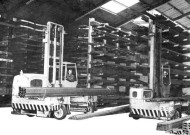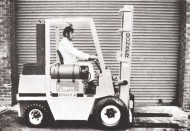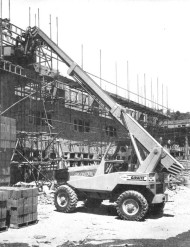 Welcome to episode sixtytwo in our exclusive series on the history of the fork lift truck, the machine which over the decades has revolutionised the face of materials handling around the world. We’ve now reached 1976, the year Apple Computers were launched, Harold Wilson resigned as Prime Minister, Bill Grundy interviewed the Sex Pistols on TV and they became notorious overnight and Coventry Climax entered the side loader market.
Welcome to episode sixtytwo in our exclusive series on the history of the fork lift truck, the machine which over the decades has revolutionised the face of materials handling around the world. We’ve now reached 1976, the year Apple Computers were launched, Harold Wilson resigned as Prime Minister, Bill Grundy interviewed the Sex Pistols on TV and they became notorious overnight and Coventry Climax entered the side loader market.
Our writer is James Brindley, an acknowledged authority on fork lift trucks. James’s distinguished career has involved engineering and management roles with BT Rolatruc and serving as a Director of the FLTA, before he set up the National Fork Truck Heritage Centre in 2004 as Britain’s first such collection open to the public.
The Heritage Centre continues to need your support in 2012, and if you or your company would like to help in any way, you can contact James on the number below. Now sit back and enjoy the latest part of this fascinating series.
Episode 62: Wilson resigns: Sex Pistols storm TV: Coventry Climax expands
In April 1976 Coventry Climax acquired Joshua and Shaw Ltd of Batley, Yorkshire from the receiver for £450,000. The idea was to extend their range of equipment to contain side loaders, to lift up to and over 25 tons and a complimentary range of hydrostatically controlled fork lift trucks. The side loaders included were the “Navigator” model N60H (electric) and the “Navigator” model N66D (diesel). The photo shows these trucks working at Leah and Rowbotham’s warehouse in Stockport, unloading and warehousing bars and sections in two ton loads within firtree racking.
 In addition the new acquisition included “Overlander” rough terrain trucks and pantograph reach trucks made under licence from the Raymond Corporation of the USA. There were also “Defiant”, counterbalanced reach and side loader trucks, all of which were re-named Climax-Shawloader and integrated into the Coventry Climax range. To meet the expansion programme the premises at Batley were expanded and modernised. Also, as part of the company’s overall plans a new spare parts storage warehouse of 40,000 square feet was opened in Mile Lane, Coventry and a new machine complex came on line at the Quinton Road site.
In addition the new acquisition included “Overlander” rough terrain trucks and pantograph reach trucks made under licence from the Raymond Corporation of the USA. There were also “Defiant”, counterbalanced reach and side loader trucks, all of which were re-named Climax-Shawloader and integrated into the Coventry Climax range. To meet the expansion programme the premises at Batley were expanded and modernised. Also, as part of the company’s overall plans a new spare parts storage warehouse of 40,000 square feet was opened in Mile Lane, Coventry and a new machine complex came on line at the Quinton Road site.
Within months of the Coventry Climax expansion the Kaye Organisation acquired the shares of the Henley Group, making it the UK’s largest industrial group. This takeover immediately gave the company the size and capability to take on the American and Japanese competition. The joining of Lansing Bagnall, a subsidiary of the Kaye Organisation, and Henley created Europe’s largest exporter of forklift trucks. The largest single benefit was that it gave the new group’s salesmen an extended range that went from small hand pallet trucks to large diesel powered trucks that could lift up to 40 tons.
Bonser forklift trucks announced news of additions to their “Super Kilo” series diesel engine models, introduced the previous year. These were the G2000K and G2500K LPG powered machines. A major feature quoted by the company was that the engines were designed from the reliable Ford Cortina 1600cc petrol engine, and as such would give an assured tried and tested performance. A further statement concerned the gas bottle and the fact that it fitted within the confines of the truck’s profile. This item could be either the 15 or 18 kg size, and because of it being at a waist high position, could be lifted on and off singlehanded. Rated lift capacities on these machines were 2000kg and 2,500kg respectively at 500mm load centres.
 A purpose made forklift truck for the construction industry was put onto the market at the beginning of 1976, and some eight months later was classed as a big success. Designed by the Liner Concrete Machinery Company, the “Giraffe” was based on their 60 years’ experience of making construction site machinery. The truck’s most noticeable feature was that it had no mast, but instead had a telescopic boom with a variable position fork carriage attached on the furthermost end. The main features were a reach of nearly 4 metres from the front wheels and the ability to lift to four storeys high and also place a load below ground level. The fork carriage automatically maintained the forks in a horizontal position throughout raising and lowering, which the operator could override manually to take into account the load level when on an incline.
A purpose made forklift truck for the construction industry was put onto the market at the beginning of 1976, and some eight months later was classed as a big success. Designed by the Liner Concrete Machinery Company, the “Giraffe” was based on their 60 years’ experience of making construction site machinery. The truck’s most noticeable feature was that it had no mast, but instead had a telescopic boom with a variable position fork carriage attached on the furthermost end. The main features were a reach of nearly 4 metres from the front wheels and the ability to lift to four storeys high and also place a load below ground level. The fork carriage automatically maintained the forks in a horizontal position throughout raising and lowering, which the operator could override manually to take into account the load level when on an incline.
By James Brindley, Director, National Fork Truck Heritage Centre.
To be continued…
tôi mu?n xem K?t qu? bóng ?á – hôm nay ! Aviator game’s attention to real-life physics is commendable.




1 Comment
I have a liner giraffe it has a 3 cylinder perkins engine manual transmission and 3 low and 3 high gears